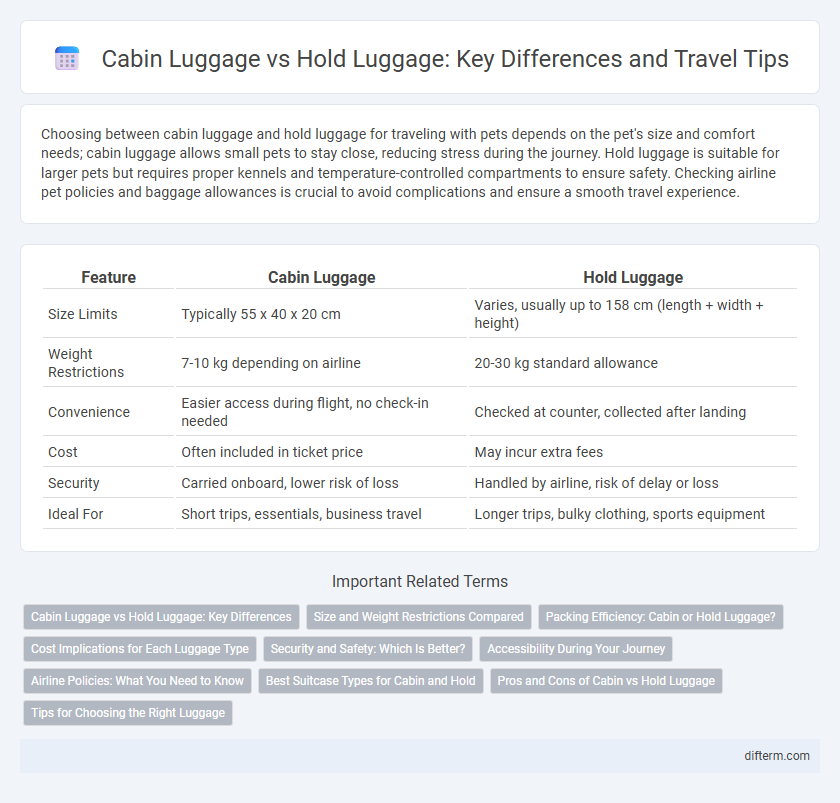Choosing between cabin luggage and hold luggage for traveling with pets depends on the pet's size and comfort needs; cabin luggage allows small pets to stay close, reducing stress during the journey. Hold luggage is suitable for larger pets but requires proper kennels and temperature-controlled compartments to ensure safety. Checking airline pet policies and baggage allowances is crucial to avoid complications and ensure a smooth travel experience.
Table of Comparison
| Feature | Cabin Luggage | Hold Luggage |
|---|---|---|
| Size Limits | Typically 55 x 40 x 20 cm | Varies, usually up to 158 cm (length + width + height) |
| Weight Restrictions | 7-10 kg depending on airline | 20-30 kg standard allowance |
| Convenience | Easier access during flight, no check-in needed | Checked at counter, collected after landing |
| Cost | Often included in ticket price | May incur extra fees |
| Security | Carried onboard, lower risk of loss | Handled by airline, risk of delay or loss |
| Ideal For | Short trips, essentials, business travel | Longer trips, bulky clothing, sports equipment |
Cabin Luggage vs Hold Luggage: Key Differences
Cabin luggage is designed for carry-on convenience, typically adhering to airline size limits of around 55 x 40 x 20 cm and weighing up to 7-10 kg, while hold luggage is checked in and can weigh up to 23-32 kg depending on the airline's policy. Cabin bags offer easy access to essentials during the flight and eliminate wait times at baggage claim, whereas hold luggage allows travelers to pack more items for longer trips. Airlines like Ryanair, British Airways, and Delta have distinct regulations and fees, making it crucial to understand the restrictions for both cabin and hold luggage to avoid extra charges.
Size and Weight Restrictions Compared
Cabin luggage typically must not exceed 22 x 14 x 9 inches and weigh up to 7-10 kg, ensuring it fits in overhead compartments for easy access during flights. Hold luggage size restrictions vary by airline but generally allow larger dimensions up to 62 linear inches (length + width + height) with weight limits ranging from 20 to 32 kg, depending on the ticket class and airline policies. Understanding these size and weight restrictions is essential to avoid extra fees and ensure a smooth travel experience.
Packing Efficiency: Cabin or Hold Luggage?
Cabin luggage offers packing efficiency by enabling travelers to organize essentials in compact compartments, making items easily accessible during flights. Hold luggage allows for larger capacity, accommodating bulkier items but requiring more strategic packing to maximize space and prevent damage. Optimizing packing efficiency depends on trip duration and airline regulations, balancing size restrictions with the need for convenience and accessibility.
Cost Implications for Each Luggage Type
Cabin luggage typically incurs no extra cost as it is included in the standard fare, while hold luggage often involves additional fees that vary by airline and flight route. Excess weight or size in hold luggage results in further charges, significantly increasing travel expenses. Budget travelers benefit from minimizing hold luggage to avoid costly surcharges, whereas premium tickets may include complementary checked baggage.
Security and Safety: Which Is Better?
Cabin luggage offers enhanced security by remaining within your personal control throughout the journey, reducing the risk of theft or loss. Hold luggage, while offering more space, is more vulnerable to mishandling and delayed retrieval due to screening and transfer processes. Travelers prioritizing safety should consider cabin luggage for valuable items and essentials, while hold luggage suits bulkier, less sensitive belongings.
Accessibility During Your Journey
Cabin luggage offers immediate accessibility, allowing travelers to keep essentials like passports, electronics, and valuables within reach throughout the journey. Hold luggage, stored in the aircraft's cargo hold, is inaccessible until arrival, requiring careful planning to avoid inconvenience. Choosing cabin luggage enhances convenience, while hold luggage accommodates larger or heavier items that might be restricted in the cabin.
Airline Policies: What You Need to Know
Airline policies on cabin luggage and hold luggage vary significantly by carrier, often dictating size, weight limits, and fee structures. Most airlines allow one cabin bag and a personal item free of charge, while hold luggage typically incurs additional fees based on weight and destination. Understanding the specific regulations of your chosen airline helps avoid unexpected charges and ensures smooth boarding processes.
Best Suitcase Types for Cabin and Hold
Hard-shell suitcases with spinner wheels offer optimal protection and maneuverability for cabin luggage, fitting airline size restrictions while maximizing space. For hold luggage, durable polyester or ballistic nylon suitcases with reinforced corners and larger capacities accommodate heavier and bulkier items, ensuring longevity during rough handling. Choosing lightweight materials with secure zippers and TSA-approved locks enhances convenience and safety for both cabin and hold baggage options.
Pros and Cons of Cabin vs Hold Luggage
Cabin luggage offers easy access to essentials during the flight and eliminates the risk of lost bags, but it is limited in size and weight, restricting what you can pack. Hold luggage provides more space for bulkier items and longer trips but involves check-in time, potential delays, and the risk of damage or loss. Choosing between cabin and hold luggage depends on trip duration, airline policies, and personal convenience preferences.
Tips for Choosing the Right Luggage
When selecting between cabin luggage and hold luggage, consider airline size restrictions and the duration of your trip to optimize convenience and avoid extra fees. Cabin luggage offers easy access and faster airport transit, ideal for short trips, while hold luggage provides greater capacity for longer journeys. Choose lightweight, durable materials with organized compartments to enhance packing efficiency and protect belongings during transit.
cabin luggage vs hold luggage Infographic

 difterm.com
difterm.com